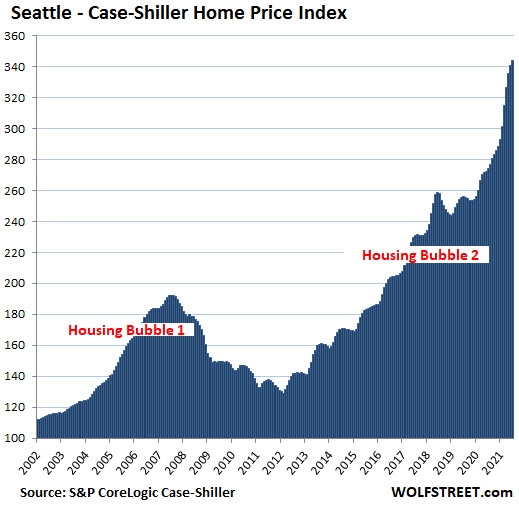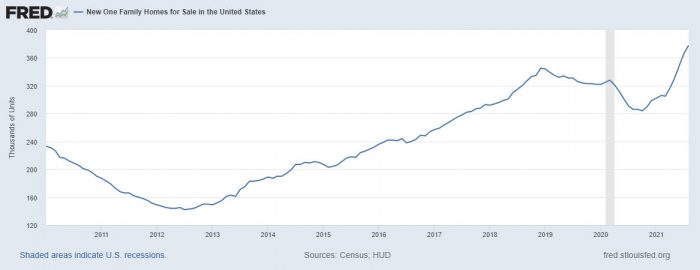The housing market is on the verge of spinning out of control. Just about everything that could be going wrong IS going wrong.
 Bullion.Directory precious metals analysis 08 October, 2021
Bullion.Directory precious metals analysis 08 October, 2021
By Peter Reagan
Financial Market Strategist at Birch Gold Group
Unfortunately, like stocks, home prices can drop like a rock at a moment’s notice. That’s one lesson we learned all too well in 2008. Another Great Recession-type plummet in home prices forces many buyers underwater, stranding them with an asset they overpaid for and can no longer afford, and can’t even sell.
Let’s start our brief examination of today’s overheated housing market by taking a glance at how the Fed has been propping it up so far.
How the Fed props up housing prices
The Fed employs various financial interventions to coax the economy in the direction they choose. We know the words: quantitative easing. Lowering interest rates. Repo and reverse repo. Obscure financial hocus-pocus that nevertheless moves markets worldwide.
When it comes to the housing market, the Fed doesn’t need to do anything fancy. They just create artificial demand for mortgage-backed securities (MBS, also known as one of the notorious “toxic assets” that poisoned the U.S. in 2008).
Mike Shedlock revealed the trick:
In a single week the Fed added $22 billion in mortgage backed securities, nearly all of which had a duration of 10 years or longer. This is an ongoing process despite major subtractions via reverse repos. In the process, the Fed gooses housing by extending the duration of the assets it does hold, effectively lowering long-term interest rates in the process.
See? If the Fed wants to “support” housing prices, all they have to do is buy up mortgages. That keeps mortgage rates low, which lets Americans buy more and bigger houses, which stimulates the construction sector, which means lots of jobs for roofers and plumbers and realtors and bankers.
It’s a win/win! Right?
Well, not exactly. Because the Fed is creating artificial demand, this upsurge in housing construction, consumption and prices is based on an illusion. Your house isn’t worth more because suddenly everyone wants to live in your neighborhood. Your house is worth more because the Federal Reserve is buying up mortgages.
All this construction activity, all this growth in the appraisal value of homes isn’t based on market forces. It’s artificial.
Which means, the moment the Fed removes its support, these artificial prices will collapse.
In the meantime, though, millions of Americans are left feeling extremely wealthy and very self-satisfied as they look around the inside of their beautiful bubble.
And what a splendid bubble it is.
Today’s housing bubble makes 2008 look quaint
It’s Wolf Richter who calls today’s bubble “the most splendid,” and here’s why
According to the Case-Shiller index, home prices have been soaring nationwide: Los Angeles, San Diego, Seattle, San Francisco, New York, Portland and Miami have seen the most ridiculous heights.
For example, you can see the chart for Seattle, Washington taken from Wolf’s article, and take note of how much higher prices are now versus 2008:

Richter says, of Seattle, “House prices rose by 0.9% for the month and by 25.5% year-over-year. Since January 2000, house prices have soared 244%.”
The same house price inflation problem exists in most major cities across the U.S., and just this year prices have increased a record 19.7% according to the latest Case-Schiller data.
Prices are going up! Great if you’re an owner, but what if you’re not yet a homeowner? What if you’re a renter?
Own or rent? Now they’re equally unaffordable
“Home ownership is the least affordable since 2008,” according to the WSJ. The same piece sheds light on how much home ownership is eating into budgets across the U.S.:
Citing data from the Atlanta Fed, the Journal writes that the median American household would need just under a third, or 32.1% of its income, to cover mortgage payments on a median-priced home. Even though mortgage rates are at all time lows, that’s the most since November 2008, when the same outlays would eat up 34.2% of income.
During more stable economic times, if things got really expensive people could “escape” to rent a home as an option. But you won’t be able to escape to 49 of the 100 largest cities, per WolfStreet:
Of the 100 cities where Zumper tracks asking rents, 49 have seen rents jump by 10% to 25% in September, compared to September 2020. These are massive rent increases in nearly half the cities.
Imagine trying to rent a home in Gilbert, Arizona only to have your rent jump 24.8% from about $1250 a month all the way to $1660 in just one year. That wouldn’t provide any relief if you were previously paying a third of your income out on a mortgage.
Of course, inflation like this takes its toll, and not just on your paycheck…
Sales of new houses are falling fast
If houses are being built but not being sold, the carrying cost of those empty new houses starts to get expensive. That’s happening now, according to a “buyers’ strike” that started earlier this year.
“Sales of new single-family houses in June plunged by 6.6% from May, and dropped 32% from the peak in January,” according to a different WolfStreet article. This drop approaches levels not seen since the beginning of the pandemic in March 2020.
The tumble in new home sales is also accompanied by an increase in unsold inventory not seen since the beginning of the pandemic in 2019, and mirrors a rising trend that has been taking place since 2012-2013, which you can see on the chart below:

Even more disturbing, the current increase in unsold homes is rising much faster than any time since the 2008 financial crisis.
Echoes of the past mortgage crisis are haunting 2021. We’ve learned this lesson before. We’ve seen how quickly home prices and stock markets can plummet, wiping out decades of wealth in days.
It’s just another piece of the worldwide Everything Bubble, brought to you by the Federal Reserve’s free-money policies.
We’ve seen this movie before, and though we don’t know how long it lasts we know how it ends. There are only a few, limited safe havens from the crash ahead…
One possible solution: Reevaluate your risk exposure
Some people lost the majority of their retirement savings during the 2008-09 financial crisis. Don’t make the same mistake they did.
Excessive risk exposure is one way many people gamble with their savings. Especially in a near-zero interest rate environment, where most investments result in after-inflation losses, savers feel they must reach for yield, piling into increasingly-risky assets.
Is your personal risk exposure is in line with your goals? Are your savings diversified? Many choose precious metals, especially gold and silver, as hedges or “portfolio insurance” against risky assets. According to Investopedia:
Gold is one of the most common hedges, and it typically appreciates with an inflating dollar or volatile markets.
Gold and silver might be the right choice to help you build a stable foundation for your retirement savings. Consider protecting your savings now, and you’ll feel confident and secure regardless of the games the Federal Reserve plays with our future.
Peter Reagan

Peter Reagan is a financial market strategist at Birch Gold Group, one of America’s leading precious metals dealers, specializing in providing gold IRAs and retirement-focused precious metals portfolios.
Peter’s in-depth analysis and commentary is published across major investment portals, news channels, popular US conservative websites and most frequently on Birch Gold Group’s own website.
This article was originally published here












 Material provided on the Bullion.Directory website is strictly for informational purposes only. The content is developed from sources believed to be providing accurate information. No information on this website is intended as investment, tax or legal advice and must not be relied upon as such. Please consult legal or tax professionals for specific information regarding your individual situation. Precious metals carry risk and investors requiring advice should always consult a properly qualified advisor. Bullion.Directory, it's staff or affiliates do not accept any liability for loss, damages, or loss of profit resulting from readers investment decisions.
Material provided on the Bullion.Directory website is strictly for informational purposes only. The content is developed from sources believed to be providing accurate information. No information on this website is intended as investment, tax or legal advice and must not be relied upon as such. Please consult legal or tax professionals for specific information regarding your individual situation. Precious metals carry risk and investors requiring advice should always consult a properly qualified advisor. Bullion.Directory, it's staff or affiliates do not accept any liability for loss, damages, or loss of profit resulting from readers investment decisions.

Leave a Reply